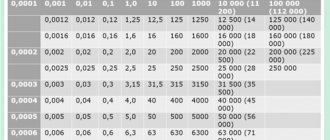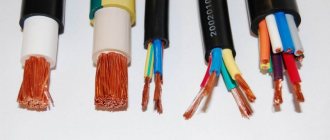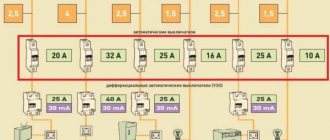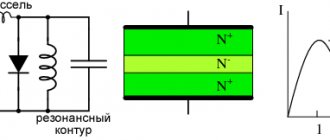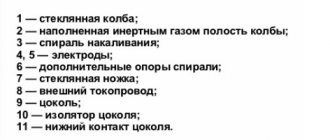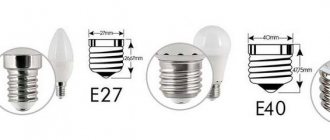Surely many of us have wondered why circuit breakers so quickly replaced outdated fuses from electrical circuits? The activity of their implementation is justified by a number of very convincing arguments, including the opportunity to buy this type of protection, which ideally matches the time-current data of specific types of electrical equipment.
Do you doubt which machine you need and don’t know how to choose it correctly? We will help you find the right solution - the article discusses the classification of these devices. As well as important characteristics that you should pay close attention to when choosing a circuit breaker.
To make it easier for you to understand the machines, the article’s material is supplemented with visual photos and useful video recommendations from experts.
Circuit breaker design
The circuit breaker consists of two releases - a thermal release and an electromagnetic release.
The thermal release is a bimetallic strip. When current flows, the plate heats up and changes its shape (bends). Thus, when a current flows that exceeds the rated current of the machine, the bimetallic plate bends so much that the machine turns off. When you turn on the machine, the spring is charged and it is fixed by a lever, which locks the machine in the on position. This very lever removes the bimetallic plate.
The electromagnetic release is designed for short circuit protection. During a short circuit, a current flows in the cable that is several times higher than the rated current of the machine. This current must be turned off immediately. For this, the mechanism of the machine uses an electromagnet - a coil and a core. When current flows, the coil retracts the core, which presses the locking lever and thus actuates the trip mechanism.
16A circuit breaker - what load can it withstand?
The existence of modern man is no longer possible without electricity. Each house, apartment, and production facility is equipped with different equipment. Rarely do property owners think about how much electricity is consumed in total - calculations are made only during the initial installation of electrical wiring. But if the network voltage is exceeded, a short circuit will occur and the network will fail. To prevent such situations, a circuit breaker is used. For domestic needs this is a 16 amp machine.
Types of response curves
The parameters of circuit breakers and their response curves (time-current characteristics) are strictly defined by the interstate standard GOST IEC 60898.
Let's look at these curves in more detail. They are constructed on a logarithmic scale. The horizontal (abscissa) axis shows the multiple of the rated current value (the ratio of the current to the rated current of the circuit breaker). The vertical axis (y-axis) shows time in seconds and minutes. The time-current characteristics can be divided into two parts: the upper descending part and the lower vertical part.
The upper part of the curve shows the operating process of the thermal release. The less the current exceeds the rated current of the machine, the slower the bimetallic plate bends and the longer it takes to turn off the machine.
The lower part shows the operation process of the electromagnetic release. This part of the response curve has a rounding near zero - this is the time of movement of the mechanical contacts when opening. This cannot happen instantly, but time is very short.
The standard provides for three types of circuit breakers with different response characteristics, which are determined by the response range of the electromagnetic release:
- Characteristic B - 3-5•Inom;
- Characteristic C - 5-10•Inom;
- Characteristic D - 10-20•Inom.
Thus, for various types of loads, an automatic machine with the appropriate characteristics is selected. For loads with low starting currents - with characteristic “B”. For loads with high starting currents (for example, motors) - with characteristic “D”.
Moreover, in the new edition of the standard - GOST IEC 60898-2-2011, the “D” characteristic is missing.
Trip characteristics of protective circuit breakers
Class AB, determined by this parameter, is indicated by a Latin letter and is marked on the body of the machine before the number corresponding to the rated current.
In accordance with the classification established by the PUE, circuit breakers are divided into several categories.
MA type machines
A distinctive feature of such devices is the absence of a thermal release. Devices of this class are installed in circuits connecting electric motors and other powerful units.
Class A devices
Type A machines, as was said, have the highest sensitivity. The thermal release in devices with time-current characteristic A most often trips when the current exceeds the nominal value AB by 30%.
The electromagnetic trip coil de-energizes the network for approximately 0.05 seconds if the electric current in the circuit exceeds the rated current by 100%. If for any reason, after doubling the electron flow, the electromagnetic solenoid does not work, the bimetallic release turns off the power within 20 - 30 seconds.
Automatic machines with time-current characteristic A are connected to lines during operation of which even short-term overloads are unacceptable. These include circuits with semiconductor elements included in them.
Class B protective devices
Devices of category B are less sensitive than those of type A. The electromagnetic release in them is triggered when the rated current is exceeded by 200%, and the response time is 0.015 seconds. Triggering of a bimetallic plate in a breaker with characteristic B at a similar excess of the AB rating takes 4-5 seconds.
Equipment of this type is intended for installation in lines that include sockets, lighting devices and other circuits where there is no starting increase in electric current or is of minimal value.
Category C machines
Type C devices are the most common in household networks. Their overload capacity is even higher than those previously described. In order for the electromagnetic release solenoid installed in such a device to operate, it is necessary that the flow of electrons passing through it exceeds the nominal value by 5 times. When the thermal release is exceeded five times the nominal value of the protection device, the thermal release is triggered within 1.5 seconds.
Installation of circuit breakers with time-current characteristic C, as we said, is usually carried out in household networks. They do an excellent job as input devices to protect the general network, while category B devices are well suited for individual branches to which groups of sockets and lighting fixtures are connected.
Circuit breakers category D
These devices have the highest overload capacity. To trigger the electromagnetic coil installed in a device of this type, it is necessary that the electric current rating of the circuit breaker be exceeded by at least 10 times.
In this case, the thermal release is activated after 0.4 seconds.
Devices with characteristic D are most often used in general networks of buildings and structures, where they play a backup role. They are triggered if there is no timely power outage by circuit breakers in individual rooms. They are also installed in circuits with large starting currents, to which, for example, electric motors are connected.
Protective devices categories K and Z
These types of machines are much less common than those described above. Type K devices have a large variation in the current required for electromagnetic tripping. So, for an alternating current circuit this indicator should exceed the nominal value by 12 times, and for a direct current circuit - by 18. The electromagnetic solenoid operates in no more than 0.02 seconds. Triggering of the thermal release in such equipment can occur when the rated current is exceeded by only 5%.
These features determine the use of type K devices in circuits with exclusively inductive loads.
Devices of type Z also have different actuation currents of the electromagnetic tripping solenoid, but the spread is not as great as in AB category K. In AC circuits, to turn them off, the current rating must be exceeded three times, and in DC networks, the value of the electric current must be in 4.5 times more than nominal.
Devices with Z characteristic are used only in lines to which electronic devices are connected.
Visually about the categories of machines in the video:
Circuit breaker testing
The standard provides for the following tests:
- The initial state of the machine is “cold”, i.e. no current was passed through it before. A current of 1.13•Inom is passed through the machine.
- The initial state of the machine is immediately after test “a”. A current of 1.45•Inom is passed through the machine.
- The initial state of the machine is “cold”. A current of 2.55•Inom is passed through the machine.
- The initial state of the machine is “cold”. of the lower is passed through the machine (3•Inom for “B”, 5•Inom for “C”).
- The initial state of the machine is “cold”. of the upper is passed through the machine (5•Inom for “B”, 10•Inom for “C”).
The result of test “a” is the absence of operation of the machine for a time t>1 hour for machines with a rated current Inom≤63A and t>2hours for machines with Inom>63A.
The result of test “b” is the operation of the machine in a time of t<1 hour for machines with a rated current Inom≤63A and t<2hours for machines with Inom>63A.
The result of test “c” is the operation of the circuit breaker within the limits of 1cnom≤32A and 1cw>32A.
The result of test “d” is the operation of the machine with characteristic “B” within the limits of 0.1snom≤32A and 0.1snom>32A; with characteristic “C” within 0.1s < t < 15s for a machine with Inom≤32A and 0.1snom>32A.
The result of test “e” is the operation of the machine in time t<0.1s.
Time-current characteristics are constructed from these points, and the points themselves are highlighted on the curves.
What are time and current characteristics of circuit breakers
During normal operation of the electrical network and all devices, electric current flows through the circuit breaker. However, if the current strength for some reason exceeds the rated values, the circuit opens due to the operation of the circuit breaker releases.
The tripping characteristic of a circuit breaker is a very important characteristic that describes how much the tripping time of the circuit breaker depends on the ratio of the current flowing through the circuit breaker to the rated current of the circuit breaker.
This characteristic is complex in that its expression requires the use of graphs. Machines with the same rating will switch off differently at different current levels depending on the type of the machine’s curve (as the current characteristic is sometimes called), making it possible to use machines with different characteristics for different types of load.
Important Takeaways
- It turns out that if the load current that flows through the machine exceeds the rated current of the machine by less than 1.13 times, then the machine will not turn off . This circumstance should be taken into account when choosing a cable.
- When designing, it should be taken into account that the requirements of clause 1.7.79 of the PUE are guaranteed to be met only if the short circuit current exceeds the upper limit of the response range, i.e. 5•Inom for characteristic “B”, 10•Inom for characteristic “C”, 20•Inom for characteristic “D”. These trip rates should be used when checking the tripping time of a circuit breaker for a single-phase short circuit.
Subscribe and receive notifications of new articles by e-mail
What are the current characteristics of circuit breakers and how they differ from each other?
As is known, the main organs for triggering a circuit breaker are thermal and electromagnetic releases.
The thermal release is a bimetal plate that bends when heated by a flowing current. Thus, the release mechanism is activated, and in the event of a prolonged overload, it is triggered with an inverse time delay. The heating of the bimetallic strip and the tripping time of the release directly depend on the overload level.
The electromagnetic release is a solenoid with a core, the magnetic field of the solenoid at a certain current draws in the core, which activates the release mechanism - instantaneous operation occurs during a short circuit, due to which the affected section of the network will not wait for the thermal release (bimetallic plate) in the circuit breaker to warm up.
The dependence of the response time of the circuit breaker on the current flowing through the circuit breaker is precisely determined by the current characteristic of the circuit breaker .
Probably everyone has noticed the image of the Latin letters B, C, D on the bodies of modular machines. So, they characterize the multiple of the setting of the electromagnetic release to the nominal value of the machine, indicating its time and current characteristics.
These letters indicate the instantaneous operation current of the electromagnetic release of the machine. Simply put, the response characteristic of a circuit breaker shows the sensitivity of the circuit breaker - the lowest current at which the circuit breaker will turn off instantly.
Slot machines have several characteristics, the most common of which are:
- — B — from 3 to 5 ×In;
- — C — from 5 to 10 ×In;
- — D — from 10 to 20 ×In.
What do the numbers above mean?
Let me give you a small example. Let's say there are two machines of the same power (equal in rated current), but the response characteristics (Latin letters on the machine) are different: machines B16 and C16.
The operating range of the electromagnetic release for B16 is 16*(3.5)=48. 80A. For C16, the instantaneous response current range is 16*(5.10)=80. 160A.
At a current of 100 A, the B16 circuit breaker will turn off almost instantly, while the C16 will not turn off immediately, but after a few seconds from thermal protection (after its bimetallic plate heats up).
In residential buildings and apartments, where the loads are purely active (without large starting currents), and any powerful motors are turned on infrequently, the most sensitive and preferable for use are machines with characteristic B. Today, characteristic C is very common, which can also be used for residential and administrative buildings.
As for characteristic D, it is just suitable for powering any electric motors, large engines and other devices where there may be large starting currents when they are turned on. Also, due to the reduced sensitivity during short circuit, machines with characteristic D can be recommended for use as input ones to increase the chances of selectivity with lower group ABs during short circuit.
Agree, it is logical that the response time depends on the temperature of the machine. The machine will turn off faster if its thermal element (bimetallic plate) is heated. And vice versa, when you turn it on for the first time when the bimetal of the machine is cold, the shutdown time will be longer.
Therefore, on the graph, the upper curve characterizes the cold state of the machine, the lower curve characterizes the hot state of the machine.
The dotted line indicates the maximum operating current for machines up to 32 A.

